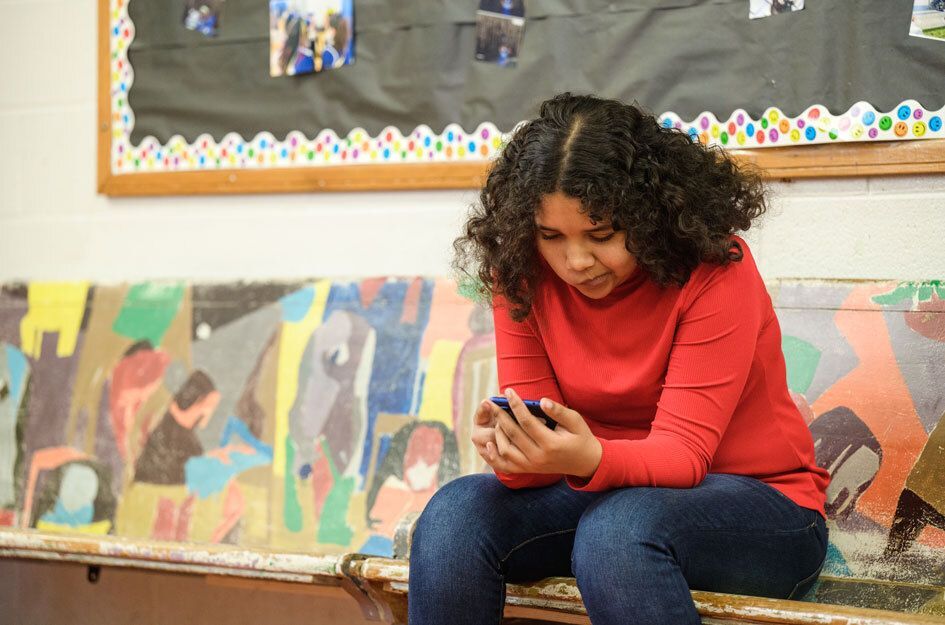
The average teenager spends 4+ hours on their phone for fun. With a few practical tips, teens, parents and teachers can strike a balance between unplugging and engaging with phones and devices.
Courtesy of Boys & Girls Club of America
Digital devices are everywhere and fulfill a lot of our everyday needs — from checking the weather and the news, to school and homework, to communicating with others — making it hard to balance unplugging from technology and engaging with it. Teens in particular may find it difficult to disconnect because, as digital natives, they have always had digital technology in their lives.
Screens aren’t necessarily a bad thing — they’re often a requirement for school or work. They can be portals to learning, discovery and greater connection with people around the world. But excessive screen time can lead to screen addiction and may cause mental health concerns like anxiety, depression, social isolation and difficulty controlling technology use.
This is especially true for teens, who are more likely to say that social media negatively affects their health and well-being. So how much screen time is too much?
The Centers for Disease Control and Prevention (CDC) recommends kids ages 11-18 limit their screen time to 1-2 hours per day. Yet on average, teens spend 4 or more hours in front of a screen for entertainment alone — not including screen time spent for schoolwork or homework.
That time could instead be spent with family, friends or pets, helping around the house, being active or getting involved in their community. As Demarion from Boys & Girls Club of Menasha, WI, says, “It is important to log off sometimes so you can focus more and get better sleep.”
That’s why on March 7, UScellular and Boys & Girls Clubs of America are joining millions around the world for Global Day of Unplugging, encouraging families and kids to engage in real-world activities that promote mindfulness, connection and well-being. “By intentionally taking a break, we can gain a greater appreciation for the role that tech plays in our lives and be better equipped to establish healthier tech habits,” says Laurent “LT” Therivel, President and CEO of UScellular.
So, whether you’re aiming to help teens (or even yourself!) disconnect from screens at home, school or in the hours in-between, here some of the best ways to unplug from technology:
Tips for Unplugging from Technology at Home
1. Be honest about your own habits
If the household rule is “no phones at the dinner table,” it can be frustrating for teens to see their parents or caregivers get around it with excuses like “I can’t miss this call,” or “I have to check my work email.” Teens are more likely to disconnect from technology if they see their parents and caregivers setting a positive example of technology themselves.
Screen time can be just as much of an issue for adults as it is for teens. Being honest about your own tech usage, including discussing with your teen how hard you might find it to unplug, can help teens feel seen and supported as you both work to build healthy habits around technology.
2. Start small
We asked Boys & Girls Club teens for their advice on unplugging, and “just try” is a mantra we heard from several teens. Start with just 30 minutes to an hour every day, ideally at the same time each day — consistency is key to building new habits. As Demarion says, “If you want to unplug, you just have to stick to it.” After a week, consider adding another 30 minutes or setting up an additional screen-free time during the week.
3. Brainstorm screen-free activities for teens
Teens might feel lost without their devices, not knowing what to do or how to spend their time. Before that first screen-free time, help them create a list of some tech-free activities they’d like to do on their own. These could be anything from walking, doing yoga and hiking, to napping or reading. It could also include trying out a new sport or hobby. Boys & Girls Club teen Paris likes to “spend time with my brother and mom,” while Hope likes to “listen to my favorite songs and sleep.”
4. Establish no-tech activities as a family
Screen-free time is a great opportunity to reconnect as a family. Together, decide on certain family activities to always enjoy without phones or other devices. For example, turn phones on silent when eating a meal together, playing a board game or spending time outside. Both teens and adults can help hold each other accountable and stick to the plan.
5. Turn off push notifications
Push notifications can be incredibly disruptive and reinforce the need to constantly check devices. Encourage teens to only keep notifications on for important things, like calls and texts from parents and caregivers. Another option is for them to place their phone on “do not disturb” for a certain amount of time. This can help teens feel more empowered to use their device with intention, rather than letting their phone interrupt real-world activities.
6. Identify problem apps
Certain apps and games are designed to be addictive and make it hard for teens (and adults!) to develop healthy habits around. If your teen finds they stay up way too late playing video games or that social media is having a negative impact on their mental health, encourage them to set time limits. Better yet, they could delete the app altogether, like Boys & Girls Club teen Leonela: “I deleted Instagram because it was a trigger for my self-esteem and body image.”
7. Get active
Not only does exercise help teens unplug from technology, but it can also counteract some of the negative impacts of too much screen time. Exercise keeps the brain healthy, can protect against anxiety and depression, promotes better sleep, strengthens bones and muscles, and more. Teens can participate in sports at school or at their local Boys & Girls Club.
Here some physical activities to encourage breaks from screens:
- Walking to and from school, or their Boys & Girls Club
- Taking the family dog for a walk or run twice a day
- Riding their bike around the neighborhood
- Dancing in their room to their favorite music
- Playing tag in the park on their way home from school or after-school activities
8. Go “old school” with your tech
Remember when we used to read the news and tell time without digital technology? Those analog alternatives still exist! Teens who like to read can try picking up a printed book, newspaper or magazine. If you use the phone to keep track of time, switch to an old-fashioned alarm clock or watch to still look at the time without getting distracted by a news alert or social media notification. Small changes like this add up and help teens feel more in control of their digital technology habits.
Tips for Unplugging in the Classroom
With more schools putting in place “no phone” policies, it’s important to help teens adapt to spending the bulk of their days with little to no phone time. If you’re a teacher, coach, counselor or other caregiver, here are more tips to help teens unplug during and after school hours.
9. Bring Learning Outside the Classroom
Find opportunities for teens to leave their phones inside by taking learning outdoors. From reading the class novel aloud under a shady tree, to collecting nature samples for a science project, these mini field trips can give teens a chance to stretch their legs, reset their minds and break up the school day.
10. Assign Group Projects with a Creative Spin
Think art, music, theater even culinary arts! Assign group projects that involve teens in hands-on art or STEM activities. This type of “active learning” gets teens off their phones and interacting face-to-face. It’s also been proven to encourage teen participation, information retention and practicing soft skills like leadership and communication. Plus, class presentations will be much more entertaining! Here 10 creative group project ideas to get you started.
11. Create a Tech-Free Zone for Students
Establishing a quiet, tech-free zone at school can provide space for teens to build healthy habits for unplugging from their devices and daily stressors. If feasible, choose a room that can be closed off for minimal interruptions. Invite parents to donate items such as fidget toys, comfortable seating, puzzles, novels, coloring books and breathing exercise cards for students to engage with. Lastly, have teens drop off their phones with a teacher or librarian before entering the space during free periods like lunch or study hall.
12. Teach Teens Digital Citizenship
Unplugging isn’t just about getting away from screens; it’s also an opportunity for teaching teens internet safety. Boys & Girls Clubs of Utah County recognized this by creating their own K-12 curriculum teaching kids and teens internet safety. Through school assemblies, they’ve educated over 70,000 local students on gaming safety, cyberbullying, social media and online predators, with teachers able to adopt their curriculum for the classroom. This Global Day of Unplugging, explore Common Sense Education’s Digital Citizenship Curriculum to help educate teens on ways to be safe online.
Digital technology is here to stay, but that doesn’t mean it has to control our lives. Establishing balance starts with finding joy in screenless activities, whether that’s connecting with family and friends, being active or exploring offline interests. As Selma from Boys & Girls Club of Door County says, “people need to know, especially teens, that there is more to life than social media.”
By starting small and committing to screen-free activities or time, teens can feel more in control of their tech habits and capable of unplugging when they want or need.
UScellular partners with Boys & Girls Clubs of America to enhance the learning experience for youth and communities by championing STEM education programs. Learning how technology works and safe best practices to using technology is a huge part of this work and we are proud to join them in educating youth on the importance of unplugging.







